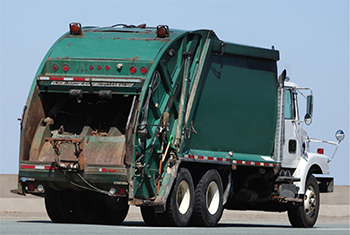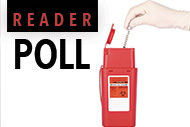Health care experts and administrative professionals have a wide variety of responsibilities demanding their attention at any given moment. With a demanding and fast-changing work environment, it’s easy to lose sight of ongoing background priorities like cost reduction. However, I would argue that saving money on overhead costs is one of the most important, impactful things anyone can do for the long-term health of their company.
Health care facilities can save money in plenty of ways, but I have found that waste removal costs, in particular, are almost always rife with opportunity. With so many different waste streams, and considerable monthly costs associated with each one, this is an oft-overlooked drain on hospital budgets.
Expose and dispose
 |
|
Photo courtesy of SIB Watch out for solid waste companies that sometimes disregard rates and fees that are part of your negotiated contract. |
The first step to ensuring you get the most value from your waste removal services while keeping costs under control is to identify your waste streams and match them to the most effective disposal method.
• Solid waste. The first and most familiar type of waste is solid waste. This is a catchall term for standard trash, such as the waste you collect in your kitchen trash can at home. Solid waste will generate the most volume of any waste stream, and health care facilities generate a lot of it, especially if they have a foodservice component. Because of the high service demands associated with solid waste, it’s a big expense. The good news is that it also provides opportunities to save money.
Your first step toward reducing your solid waste spend is to carefully scrutinize your service contract with your hauler. Check for language about fees and price increases. If it doesn’t square with the bills you’re receiving, bring it to their attention. You might be surprised how often waste haulers disregard the contract and raise rates and fees that they’re not authorized to charge. If they’re doing this, don’t just put a stop to it – demand refunds or credits for the past overcharges as well.
If, on the other hand, your contract does allow for extra fees and unlimited price increases, be sure to renegotiate a new deal as soon as you’re able. There’s no reason a hauler shouldn’t be able to commit to a steady rate – or at least a firm cap on rate increases – for a period of two or three years. Insist on these protections in your next contract so you can keep your waste removal costs from rising.
• Recycling. Recycling is another waste stream that’s becoming more central to any health care facility’s overall waste removal strategy. In addition to being environmentally friendly, recycling can divert large volumes of waste from your other waste streams. For example, cardboard waste can quickly and needlessly fill up a solid waste dumpster, causing more frequent and costly pickups. Recycle it instead. For large facilities with high volumes of recycled waste, the quantities produced can actually yield net revenue due to the value of these commodities in bulk.
However, for smaller facilities, beware that recycling sometimes can cost more than solid waste removal on a per-pound basis. Also, if single-stream recycling is not available in your area, it can be burdensome for staff to separate materials such as glass, aluminum, plastic, etc. We all want to go green, but if the green you’re most concerned with is dollars, it may be best to forgo recycling in favor of a more simplified waste stream.
• Medical waste. Medical waste is another stream that is standard in the health care industry. For safety and regulatory reasons, the careful treatment and removal of medical or biohazardous waste is not only important, it’s required, and facilities cannot compromise service quality. However, there is plenty of room to negotiate on rates. Make sure to compare costs at all your facilities to benchmark the lowest rates that you know your medical waste hauler is able to offer. Also, make sure your staff is knowledgeable about the different types of waste within this category, such as red bag waste, sharps, chemo/path waste, and pharmaceutical waste. Each one is different and come with different disposal costs per pound. It is important to reserve medical waste containers strictly for materials that must be disposed of this way, and use your other waste streams for nonessential materials. For example, were you aware that used plaster casts are considered non-biohazardous waste? These materials are voluminous and heavy, and diverting them from your medical waste stream to a common solid waste stream will save you big money in the long run.
• Shredding. Another waste stream that’s often forgotten is document shredding. In the health care industry, the use of paper documents is so widespread that even small facilities produce significant volumes of paper headed toward the shredder. These services often go hand-in-hand with off-site document storage and retrieval services. If you’re getting your shredding services from the same company that stores your archival files, you might think you’re getting a volume discount, or a package deal, but often that’s not the case. Smaller companies that only specialize in shredding can usually offer better deals and a lower service commitment.
Set clear rules internally on what needs to be shredded and what doesn’t, and you’ll cut down on your volume. Then shop around for local shredding companies. If they can offer you a better deal than your current provider, negotiate an on-demand pickup schedule at low rates. Don’t order a pickup unless all of your shred bins are full. That way, you will get the most possible value out of each pickup and take full advantage of the storage capacity you have.
Beware the cost of negligence
Waste removal doesn’t always get much attention, and that negligence can lead to serious problems. When it comes to billing errors, don’t necessarily count on your accounts payable team to notice them. If they don’t communicate often enough with your operations staff, there could be a real disconnect. Recently my company learned about a billing error for one of our clients that went unnoticed for 19 months. To the accounts payable staff, everything on the billing statement looked normal – it was only when the operations personnel took at look at the bill that they noticed they were clearly getting charged for a service they were not receiving. We fixed the problem, but it makes you wonder how long it would have gone unnoticed.
Here’s another scenario that might give you chills. Other people, even other businesses, might be using your waste containers without your knowledge. I have encountered multiple instances of small doctor’s offices avoiding costly disposal fees by simply tossing the occasional bag of medical waste into a nearby hospital’s containers. How did they get access to these facilities? In each case, the method was simple – they slipped a six-pack of beer to the maintenance crew on duty, who were more than happy to look the other way in exchange for the gift.
How do egregious problems like this go uncorrected, or even unnoticed? It’s simple: people have more important things to worry about. Administrative and operational staff can be swamped by their everyday duties or urgent situations that pop up. If they’re spending all their time putting out fires, they’ll have no time or attention to devote to simple concerns like who’s taking out the trash, or how much it costs them. Most people want to think about waste removal as little as possible – as long as their garbage goes away, everything’s fine.
The problem is that minor problems can snowball. A small monthly overcharge can multiply into a significant annual expense. Inefficient services can not only cost you money, but also impact your operations. While a full review and overhaul of your trash services might never be an urgent project, it’s also not something you can afford to ignore forever. To get control of things, consider temporarily reassigning a few administrative employees to conduct a full review, and equip them with the time and resources to keep at it until it’s done. Or better yet, hire an outside expert to do it for you. There’s no time like the present, and the benefits of acting now can pay dividends for years to come.
Dan Schneider is CEO of SIB Fixed Cost Reduction, a consulting company specializing in auditing and reducing fixed monthly costs for businesses with large facilities or multiple locations. He can be reached at dans@sibdevelopment.com.





